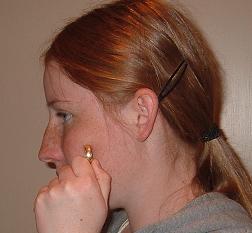The article that we are drawing from this month on knees comes from Yoga Journal
We will be learning and doing chair and eagle pose as our featured poses for the month.
It is possible to injure or slow down healing in the knees practicing yoga. You do that by practicing mindlessly, and without care or by greed. A greedy practice would be wanting to go farther in a pose than is appropriate or trying to look like someone else in the room. In addition to being moderate and practicing with care here are the 8 ways to protect your knees during a yoga practice.
1 Avoid hyperextending. When joints are overly mobile and flex too far back, they’re hyperextended. In the knees, hyperextension often occurs in poses in which the legs are straightened, such as Trikonasana (Triangle Pose) and Paschimottanasana (Seated Forward Bend), putting an unhealthy tension on the ligaments. If you’re prone to hyperextension, keep a slight bend in the knees during standing poses and keep your weight evenly distributed among the four corners of your feet. In seated forward bends, place a rolled-up sticky mat or towel under the knee of the extended leg or legs.
2 Start with your feet. Proper alignment through the feet is the key to building strength evenly in the ligaments on both sides of the knee; when all the ligaments are equally strong, the kneecap glides effortlessly up and down and the cartilage doesn’t get worn down. Separate your toes and press actively through the four corners of your feet in every pose, even inversions. If your feet are out of alignment, your knees are going to suffer.
3 Keep your knees in line. When moving into deep knee bends, such as Virabhadrasana II (Warrior Pose II) and Parsvakonasana (Side Angle Pose), first align your bent knee over your ankle, then draw your kneecap in line with your second toe. Maintain awareness in your back foot, pressing down evenly, while lifting up from the arch of your front foot. “If you let the arch drop, the knee falls inside the big toe, and you’re set up to suffer a number of different kinds of overuse and acute knee injuries,” says Angela Smith, a professor of orthopedic surgery.
4 Tune in to subtle signals. “Oftentimes, the knees don’t give immediate feedback,” explains Iyengar teacher Joni Yecalsik. “Only later do you realize you’ve gone too far. When it comes to the knees, the sensation that would normally proceed the red flag is the red flag.” If you feel achiness when you come out of a bent-knee pose, you may have worked too hard.
5 Build strength by balancing. Balancing poses, especially those that require moving through a bent standing leg, such as Garudasana (Eagle Pose), are especially beneficial. “Very dynamic balancing protects the knee against future injury by training the functional alignment, not just working the muscle,” Smith says.
6 Be prop-friendly. When it comes to seated asanas, nothing makes a tight knee happier than a bounty of props. In Virasana (Hero Pose), try raising your seat with blankets or a block. Anytime the knees are deeply bent, such as in Balasana (Child’s Pose) or Marichyasana III (Pose Dedicated to the Sage Marichi III), pressure can be relieved by placing a rolled-up washcloth as far into the knee pit as possible before bending the joint.
7 Warm up with hip openers. “If your big joints aren’t open, your small joints will always take the stress,” yoga instructor Sandy Blaine says. “Many people hurt their knees doing Lotus when their hips aren’t ready.” She recommends warming up with hip stretches like Baddha Konasana (Bound Angle Pose) and Gomukhasana (Cow Face Pose).
8. Lift the quadriceps muscle on the front of the thigh. This pulls the kneecap right into place and stabilizes the knee joint. Do this in all standing poses where there is a need for that stability but also in seated,reclined and supine poses, so the leg muscles can be strengthened isometrically.





